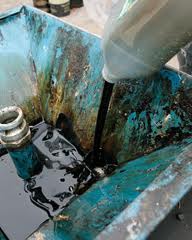Removal of cadmium (II) from aqueous waste effluents by using supported liquid membrane technology
Keywords:
Cadmium, Triethanolamine, Supported liquid membrane, Waste effluentAbstract
There is a growing need to develop technologies that can separate and selectively remove hazardous chemical species from waste effluents. Selective removal of cadmium ions through a supported liquid membrane (SLM) containing triethanolamine (TEA) as a mobile carrier has been studied. The effects of Cd(II) concentration, HCl in feed and carrier concentration in membrane has been studied. Cd(II) concentration increase in feed leads to an increase in flux from 2.1x10-7 to 8.4x10-7 mol-cm-2-sec-1 within Cd(II) ions concentration range (2.7x10-4M - 16.37x10-4M ) at 2.0M HCl in the feed and 3.0M triethanolamine in the membrane. Increase in H+ ion concentration from 0.5M to 3.0M results in an increase in Cd(II) ions flux but a decrease is observed beyond 2.0M HCl concentration in feed. Increase in carrier concentration in the liquid inside the membrane enhances the flux with its maxima at 3.0M carrier. Further increase in the concentration of TEA leads to a decrease in transport due to increase in viscosity of membrane liquid. The optimum conditions for Cd(II) ions transport are, 2.0M HCl in feed, 3.0M TEA in membrane and 0.1M NaOH as strip solution. Similar transport characteristics have been observed for Cd-EDTA complexed anions across TEA-cyclohexanone based SLM, thus indicating a cadmium anion transport coupled with protons and chloride or EDTA co-ions.
References
Alguacil, F.J., Tayibi, H., 2005. ‘Carrier facilitated transport of Cd(II) from a high salinity chloride medium across a
supported liquid membrane containing Cyanix 923 in Solvesso 100’,Desalination.,180, 181.
Ashraf ,W., Al-Malack, M.H., 2005. ‘Effect of membrane preparation method on performance of polyol supported
membrane used for separation of phenol’, Transp. Porous Media. 61,307.
Ashraf, W., Mian, A., 2006. ‘Selective separation and preconcentration studies of chromium(VI) with alamine 336
supported liquid membranes’, Environ. Toxicol. Chem. 88(2),187.
Babcock, W.C, Friesen, D.T., Lachepelle, E.D., 1986. ‘Liquid membranes for separating uranium from vanadium and
uranium from molybdenum’, J. Membr. Sci. 26,303.
Bromberg, L., Lewin, I., Warshawsky, A.,1993. ‘Membrane extraction of mercury (II) and silver (I) by bis(di(2-
ethylhexyloxy)thiophosphoryl)disulfide’,Hydrometallurgy. 33, 59.
Chaudry, M.A., Din, M., 1981.‘Uranyl ions transported through tri-n-octylaminexylene based supported liquid
membranes’,J. Radioanal. Nuc. Chem. 111(1),211.
Dansai, P.R., 1984.‘Seperation of metal species by supported liquid membranes’, Sep. Sci. Technol.,19, 857.
Danesi, P.R., Harwitz, E.P., Vandegrift, G.F., Chiarizia, R.,1981.‘Mass Transfer Rate through Liquid Membranes:
Interfacial Chemical Reactions and Diffusion as Simultaneous Permeability Controlling Factors’,Sep. Sci.
Technol. 16 (2), 201.
Danesi, P.R., Yinger, R., 1986. ‘A composite supported liquid membrane for ultraclean Co—Ni separations’, J.
Membr. Sci.,27, 339.
Environmental Bureau of Investigation;www.eprf.ca/ebi/cadmium.html
He, D., Ma, M., Zhao, Z., 2000. ‘Transport of cadmium ions through a liquid membrane containing amine
extractants as carriers’, J. Membr. Sci. 169,53.
Hernandez-Cruz, I., Lapidos, G., Carrilo-Roma, F., 1998. ‘Modelling of nickel permeation through a supported liquid
membrane’, Hydrometallurgy. 48, 265.
Ibanez, J.A., Victoria, L., Hernandez, A., 1989. ‘Flux and Characteristic Parameters in Mediated Transport through
Liquid Membranes. I. A Theoretical Model’, Sep. Sci. Technol. 24 (1-2), 157.
Inoue, Y., 1990. Mechanistic Principles of Liquid Membranes Transport, in: T. Araki, H. Tsuku-be (Eds.), Liquid
Membranes: Chemical Applications, CRC Press, Boca Raton, FL.
Marchese, J., Campderros, M., 2004. ‘Liquid–liquid extraction of cadmium(II) by Cyanex 923 and its application to a
solid-supported liquid membrane system’, Desalination. 164,141.
Marchese, J., Campderros, M.E., Achosta, A., 1993. ‘Mechanistic study of cobalt, nickel and copper transfer across
a supported liquid membrane’, J. Chem. Technol. Biotechnol. 57, 37.
Nair, S.G., Hwang, S.T., 1991. ‘Supported liquid membranes for enantioselective transport of amino acid mediated
by chiral crown ether - effect of membrane solvent on transport rate and membrane stability’, J. Membr. Sci.
,69.
Nowier, H.G., El-Said, H.F., 2000. ‘Transport of Cd(II) from high salinity chloride medium through supported
containing TBP/cyclohexane’,Jr.Memb.Sci. 177,41.
Pecksock, R.L., Shields, L.D., Cairns, T., 1976. Modern Methods of Chemical Analysis, 2nd Ed, John Wiley & Sons,
New York.
Tripathy, S.S., Kadambini, S., Das, R.P., 2002. ‘Extraction of Cd (II) by supported liquid membrane using TOPS-99 as
mobile carrier’, Sep. Sci. Technol. 37(12), 2897.
Urtiaga, A.M., Alonso, A., Ortiz, I., Daud, J.A., El-Reefy, S.A., 2000. ‘Comparison of liquid membrane processes for
the removal of cadmium from wet phosphoric acid’, J. Membr, Sci. 164, 229.
Wilkinson, G., Cotton, F.A., 1999. Advanced Inorganic Chemistry. 6th Ed. John Wiley & Sons.

Published
How to Cite
Issue
Section
License
Copyright (c) 2012 Muhammad Waqar Ashraf, Malik A. Iqbal

This work is licensed under a Creative Commons Attribution-NonCommercial-NoDerivatives 4.0 International License.



